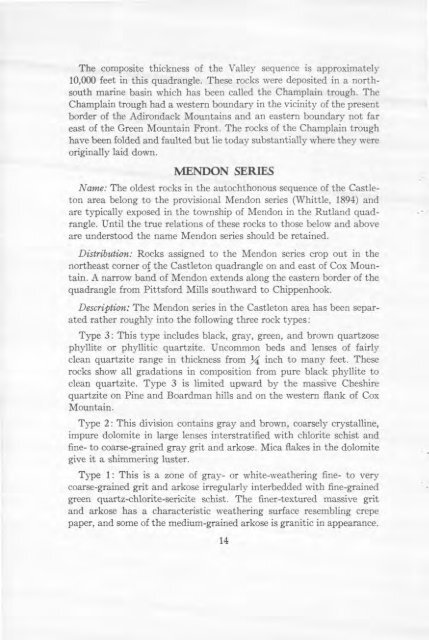STRATIGRAPHY AND STRUCTURE CASTLETON AREA VERMONT
STRATIGRAPHY AND STRUCTURE CASTLETON AREA VERMONT
STRATIGRAPHY AND STRUCTURE CASTLETON AREA VERMONT
You also want an ePaper? Increase the reach of your titles
YUMPU automatically turns print PDFs into web optimized ePapers that Google loves.
The composite thickness of the Valley sequence is approximately<br />
10,000 feet in this quadrangle. These rocks were deposited in a northsouth<br />
marine basin which has been called the Champlain trough. The<br />
Champlain trough had a western boundary in the vicinity of the present<br />
border of the Adirondack Mountains and an eastern boundary not far<br />
east of the Green Mountain Front. The rocks of the Champlain trough<br />
have been folded and faulted but lie today substantially where they were<br />
originally laid down.<br />
MENDON SERIES<br />
Name: The oldest rocks in the autochthonous sequence of the Castleton<br />
area belong to the provisional Mendon series (Whittle, 1894) and<br />
are typically exposed in the township of Mendon in the Rutland quadrangle.<br />
Until the true relations of these rocks to those below and above<br />
are understood the name Mendon series should be retained.<br />
Distribution: Rocks assigned to the Mendon series crop out in the<br />
northeast corner of the Castleton quadrangle on and east of Cox Mountain.<br />
A narrow band of Mendon extends along the eastern border of the<br />
quadrangle from Pittsford Mills southward to Chippenhook.<br />
Description: The Mendon series in the Castleton area has been separated<br />
rather roughly into the following three rock types:<br />
Type 3: This type includes black, gray, green, and brown quartzose<br />
phyllite or phyllitic quartzite. Uncommon beds and lenses of fairly<br />
clean quartzite range in thickness from Y4 inch to many feet. These<br />
rocks show all gradations in composition from pure black phyllite to<br />
clean quartzite. Type 3 is limited upward by the massive Cheshire<br />
quartzite on Pine and Boardman hills and on the western flank of Cox<br />
Mountain.<br />
Type 2: This division contains gray and brown, coarsely crystalline,<br />
impure dolomite in large lenses interstratified with chlorite schist and<br />
fine- to coarse-grained gray grit and arkose. Mica flakes in the dolomite<br />
give it a shimmering luster.<br />
Type 1: This is a zone of gray- or white-weathering fine- to very<br />
coarse-grained grit and arkose irregularly interbedded with fine-grained<br />
green quartz-chlorite-sericite schist. The finer-textured massive grit<br />
and arkose has a characteristic weathering surface resembling crepe<br />
paper, and some of the medium-grained arkose is granitic in appearance.<br />
14













